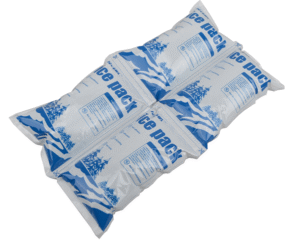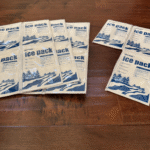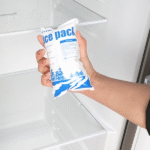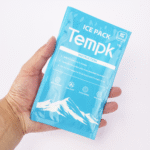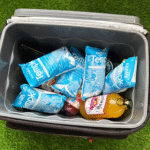Coussinets de glace sec: Comment choisir, Taille & Expédier 2025
Si vous expédiez des denrées périssantes, dry ice pads can keep food safe or frozen when used correctly—and compliant labeling matters when real dry ice (co₂ solide) is involved. Start with simple rules: plan 5–10 lb de glace sèche par 24 heures for deep-frozen lanes and keep chilled foods ≤40 ° F (4°C) end-to-end. Pour les voyages de passagers, dry ice is limited to 2.5 kg par forfait. Mis à jour: Août 18, 2025.
-
Choisissez le bon dry ice pads type for chilled vs. voies gelées (queue: dry ice pads for shipping food).
-
Calculer how many dry ice pads or pounds of dry ice you need for 24–72 hours (queue: how many dry ice pads do I need).
-
Pack and label UN1845 dry ice correctly in 2025 to avoid rejections (queue: règles d'expédition de glace carbonique 2025).
-
Utiliser PCM pads and gel packs to skip hazmat when deep-freeze isn’t required.
What are dry ice pads—and which type do you need?
Réponse courte: Dry ice pads can mean two things. Insulated dry ice pads are fabric covers used with real dry ice Pour ralentir la sublimation. Reusable “dry-ice‑style pads” are polymer/PCM sheets you hydrate or freeze; ils sont pas CO₂ and suit chilled or moderate frozen ranges. Use real dry ice for ultracold (−78,5 ° C) and use pads/PCM for 2–8°C or −10°C to −20°C targets.
Pourquoi ça compte: Real dry ice requires vented packaging and UN1845 marques; reusable pads/PCM don’t release gas and avoid hazmat paperwork, making handoffs simpler for many food lanes.
When should you choose PCM “dry ice pads” vs. vraie glace sèche?
Pour −20°C frozen but not ultracold: prendre PCM pads (Par exemple, 5°F/−15°C setpoints) to stabilize loads without CO₂ handling. Pour ultracold or hard-frozen (glace, long-haul meats), choisir vraie glace sèche and vent the shipper. De toute façon, pre-chill products and fill voids to slow heat gain.
| Pad / Type de réfrigérant | Qu'est-ce que c'est | Bande de température typique | Ce que cela signifie pour vous |
|---|---|---|---|
| Insulated dry ice pad (cover) | Fabric/insulated topper used avec glace carbonique | Works with −78.5°C | Reduces sublimation during frequent access; not a coolant by itself. |
| Hydrated “dry-ice‑style” pad sheet | Polymer cells you wet/freeze | ~10–32°F (−12–0°C) | Great for 2–8°C chilled; facile, non‑hazmat; flexible fit. |
| PCM panel (~5°F/−15°C) | Fixed‑setpoint phase‑change pack | ~5–20°F (−15–−6°C) | Bridges chilled–frozen gap; more stable than gel; no CO₂ gas. |
| Glace sèche (Co₂, UN1845) | Solid carbon dioxide | −78,5 ° C (−109,3 ° F) | Best for ultracold; nécessite une ventilation + étiquetage; plan mass carefully. |
Conseils pratiques pour vous
-
Frequent access? Add an insulated dry ice pad over dry ice between picks to slow loss.
-
Voies réfrigérées (≤40 ° F): Utiliser dry ice pads (sheets/gel) and pack tight; add a 5°F PCM if ambient is hot.
-
Congelé (−20°C) Sans Hazmat: Utiliser PCM pads around the payload for a flat cold plateau.
Vraie cas: A cheesecake brand compared six “dry‑ice‑style” pads + two PCM panels vs. 12 lb dry ice in a 30‑qt shipper over 30 heures. Pads/PCM held 34–38°F with zero leaks; La glace sèche maintenue rock‑solid frozen—ideal for hard‑frozen SKUs.
How many dry ice pads—or pounds of dry ice—do you need?
Planning rules you can trust: Pour glacé voies, commencer par ≈1 lb of pad/gel per cubic foot per 24 h; scale up 25–50% for hot routes or thin insulation. Pour profond, plan 5–10 lb de glace sèche par 24 h per well‑insulated box. Validate with a small test and a logger before you scale.
Estimateur rapide (copier / coller):
| Taille du conteneur | Dry ice pads pour 24 h (glacé) | Glace sèche pour 24 h (congelé) | Ce que cela signifie pour vous |
|---|---|---|---|
| 25Expéditeur de T-T | 2–3 hydrated pad sheets + 1 PCM panel | ~10–15 lb | Pads hit 33–40°F; use dry ice for hard‑frozen outcomes. |
| 45Expéditeur de T-T | 4–5 pad sheets + 2 Panneaux PCM | ~15–20 lb | Layer top & bottom for uniform temps. |
| 60Expéditeur de T-T | 6 pad sheets + 2–3 PCM panels | ~18–25 lb | Fill voids and pre‑chill cargo to slow heat gain. |
Field‑tested sizing cues
-
Hot route or long transit? Ajouter 25–50% coolant and consider PCM to smooth swings.
-
Benchmark: A 25‑qt cooler typically needs ~10–15 lb/day of dry ice for frozen results.
How to pack with dry ice pads (and with dry ice) for safe delivery?
Chilled with pads/PCM/gel (pas de danger):
Préchauffeur product ≤40°F; line bottom with pads; flank with PCM on the sides; top with gel; remplir les vides; pleinement joint (no vent needed for pads/gel).
Frozen with dry ice (patrie):
Freeze solid, lieu glace sèche sur le dessus (puits de froid), vent package, et marque: «Glace sèche» ou «dioxyde de carbone, solide,» UN1845, Poids net de la glace sèche (kg), plus Classe 9 étiquette. Suivez le 2025 liste de contrôle d'acceptation.
Étiquetage & 2025 compliance made simple (UN1845)
-
Ventilation: Never airtight—allow CO₂ to escape to avoid rupture.
-
Marques: Nom d'expédition approprié, UN1845, Kg net, expéditeur / destinataire, Classe 9 diamant.
-
Voyage en avion: 2.5 kg dry ice per passenger package, Approbation des compagnies aériennes requises.
-
Postal/Express: Air USPS ≤ 5 lb; FedEx/UPS mirror IATA/49 CFR for packaging & marques.
Texte d'étiquette prêt à la copie (exemple):
Pro tips that prevent warm arrivals
-
Precondition: Freeze PCM/gel 24–36 h; pre‑chill boxes.
-
Placement: Glace sèche en haut; coussinets bas + haut; minimiser l'espace de tête.
-
Validation: Drop a mini temperature logger in pilot boxes; standardize SOPs by lane.
Case in one line: With six pad sheets + two PCM panels, a 30‑hour lane held 34–38°F and avoided DG fees, while the same box with 12 lb de glace sèche arrived frozen solid. Choose per SKU and promise.
2025 trends in dry ice pads & cold chain—what changed?
Instantané: Le 2025 VOICI DGR (66l'éd.) and carrier checklists formalize UN1845 weight/marking clarity; Adoption du PCM grows as brands seek non‑DG stability for −20°C runs; Revêtements VIP and better insulation reduce required coolant mass. Expect hybrid packs: PCM dry ice pads around the payload, avec un smaller dry‑ice topper for margin.
Dernier progrès en un coup d'œil
-
Checklist clarity: Fewer acceptance rejections when UN1845 and net kg are on the same panel.
-
−20°C PCM maturity: More vendors, better hold times, simpler reconditioning.
-
CO₂ supply dynamics: Mixed strategies hedge price/availability risk with PCM hybrids.
Perspicacité du marché: As insulation improves (Par exemple, Revêtements VIP), you’ll often ship the same payload with fewer pads or less dry ice, trimming freight and DG fees without sacrificing temperature.
Questions fréquemment posées
1) Are dry ice pads the same as dry ice?
Non. Insulated pads cover real dry ice to slow loss; reusable “dry‑ice‑style” pads are gel / pcm and suit chilled/moderate frozen—pas ultracold −78.5°C.
2) Combien de glace sèche par jour dois-je planifier?
Commencer par 5–10 lb par 24 h in a quality shipper; add 20–30% for summer lanes; verify with a test.
3) Do PCM “dry ice pads” need hazmat labels?
Non. PCM pads don’t release CO₂ gas and don’t require Class 9 labels—still validate duration.
4) Puis-je voler avec de la neige carbonique?
Oui, jusqu'à 2.5 kg per passenger package in a ventilé container with airline approval and proper marks.
5) What food safety target should I follow for chilled shipments?
Keep foods ≤40 ° F (4°C) from packout through delivery; log pilot runs to confirm.
Résumé & étapes suivantes
Points clés: Utiliser dry ice pads (pads/gel/PCM) for chilled or −20°C lanes; choisir glace carbonique for ultracold, et secouer + Étiquette un1845 correctement. Plan 1 lb/ft³/24 h for pads/gel and 5–10 lb/24 h pour la glace sèche, puis valider avec un bûcheron. Conserver la nourriture ≤40 ° F across the journey.
Plan d'action:
-
Set your temperature goal (réfrigéré vs. congelé).
-
Choisissez le liquide de refroidissement: pads/PCM for chilled/−20°C; glace sèche pour ultracold.
-
Utilisez l'estimateur ci-dessus; add a summer buffer.
-
Print labels (si vous utilisez de la glace carbonique) et suivre le 2025 liste de contrôle.
-
Run a lane pilot, review data, then codify your SOP.
60‑Second Coolant Picker (liste de contrôle interactive)
-
I need ultrafroid (≤−70°C) → Glace sèche + insulated pad cover; Étiquette UN1845; ventilé.
-
I need congelé (−20°C) → PCM “dry ice pads” around payload; avoid DG paperwork.
-
I need glacé (2–8 ° C) → Hydrated pad sheets/gel; full coverage; espace libre minimal.
À propos du tempk
We design cold‑chain systems that meet your exact temperature and duration at the lowest total landed cost. Nos ingénieurs Benchmark dry ice pads, gel, PCM, et isolation against your lanes, puis livrer des sops clairs, safety notes, and label templates—validated with data loggers.
CTA: Want a free one‑lane packout template or sizing check? Parlez à un spécialiste du tempk aujourd'hui.






